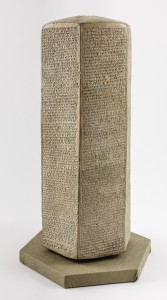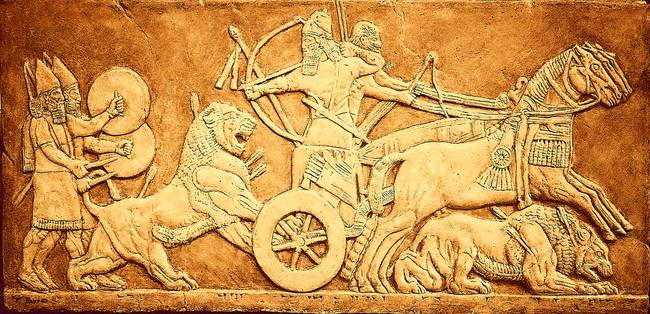This is now the 4th installment of “Where Archaeology Meets The Bible”. The previous installments can be found below in chronological order.
#1 Kassite Period [1600-1160 BCE].
#2 Middle Babylonian Period [1000 – 625 BCE].
#3 Middle Babylonian Period [1000 – 625 BCE].
Below I will be examining a number of texts from the Akkadian and Babylonian time of domination in the Ancient Near East (ANE). As I noted in previous posts, almost all of my data was pulled from Context Of Scripture, a 3 volume set containing archaeological data from the ANE. I would also like to note that many of these same findings can be found online at biblical archaeology sites like http://www.biblicalarchaeology.org/
http://ancientworldonline.blogspot.com
http://krc.orient.ox.ac.uk/ociana/index.php
As I did in the previous post, here is a timeline of the events being examined. We start today on the top portion of this timeline right before the Assyrian Destruction in 721 and we will go into the meat of the Assyrian destruction by Sargon II and Sennacherib, ending on Nebuchadnezzar. We will also so that now southern Israel is being attacked as well as the north. Hezekiah is defeated in Jerusalem.
Inscriptions in and on Sargon’s palace tell of the defeat of Hezekiah
During the reign of the Assyrian king, Sargon II, Judah is being besieged in the 14th year of Hezekiah (2 Kings 18:13). The military record of Sargon II in Israel is found on clay tablets in Sargon’s palace in Khorsabad. These retell the story plus some extra information.
In this account 27,290 more people are exiled and 50 chariots taken.
[The inhabitants of Sa]merina, who agreed [and plotted] with a king [hostile to] me, not to do service and not to bring tribute [to Ashshur] and who did battle, I fought against them with the power of the great gods, my lords. I counted as spoil 27,280 people, together with their chariots, and gods, in which they trusted. I formed a unit with 200 of [their] chariots for my royal force. I settled the rest of them in the midst of Assyria. I repopulated Samerina more than before. I brought into it people from countries conquered by my hands. I appointed my eunuch as governor over them. And I counted them as Assyrians.
(COS 2.118E, pg. 296-297)
With the power and might of Ashur, my lord, I overwhelmed the district of Hezekiah of Judah…Azekah, his stronghold, which is located between my land and the land of Judah…I besieged by means of beaten earth ramps, by great battering rams brought near its walls, and with the attack of foot soldiers […] They had seen the…of my cavalry and they had heard the roar of the mighty troops of the god Ashur, and their hearts became afraid. I captured this stronghold, I carried off its spoil, I destroyed, I devastated, I burned with fire. I approached Ekron, a royal city of the Philistines, which Hezekiah had captured and strengthened for himself….His skillful battle warriors he caused to enter into it.
(COS 2, 2.119D, pg. 304)
The exiles were taught skills and an even heavier tribute was placed on the people remaining in the land. After Samaria, Sargon II continued into Egypt. Egypt had previously conspired with Hosea of Israel (2 Kings 17:3-5), and he defeated them in battle. This time Sargon tells of his abolishing of Azuri the king of Ashdod (in connection with Isaiah 20:1 from previous paragraph), who plotted against him. This defeat of Egypt is significant because Isaiah prophesied in that year that Egypt would fall to Sargon, king of Assyria (Isaiah 20:1-6).
In the year that the supreme commander, sent by Sargon king of Assyria, came to Ashdod and attacked and captured it— 2at that time the Lord spoke through Isaiah son of Amoz. He said to him, “Take off the sackcloth from your body and the sandals from your feet.” And he did so, going around stripped and barefoot.
3Then the Lord said, “Just as my servant Isaiah has gone stripped and barefoot for three years, as a sign and portent against Egypt and Cush, 4so the king of Assyria will lead away stripped and barefoot the Egyptian captives and Cushite exiles, young and old, with buttocks bared—to Egypt’s shame. 5Those who trusted in Cush and boasted in Egypt will be dismayed and put to shame. 6In that day the people who live on this coast will say, ‘See what has happened to those we relied on, those we fled to for help and deliverance from the king of Assyria! How then can we escape?’ ” (Isaiah 20:1-6 NIV)
 Sennacherib tells of the final siege and capture of Jerusalem
Sennacherib tells of the final siege and capture of Jerusalem
The next big turn of events was the ascension of Sennacherib to the throne of Assyria (704-681BC). Sennacherib went against Hezekiah in battle at the Philistine strong-hold. As stated by 2 Kings 18:7-8, before the death of Hoshea, Hezekiah of Judah rebelled against the king of Assyria, and took over the Philistine territory as his own defense point.
 Sennacherib records in a letter to his god Ashur that he destroyed the royal city of the Philistines, which Hezekiah had taken for himself. He describes the city as be surrounded by great towers that are most difficult, which is in agreement with the biblical account; having watchtowers and being very fortified (2 Kings 18:8).
Sennacherib records in a letter to his god Ashur that he destroyed the royal city of the Philistines, which Hezekiah had taken for himself. He describes the city as be surrounded by great towers that are most difficult, which is in agreement with the biblical account; having watchtowers and being very fortified (2 Kings 18:8).
In a later account of Sennacherib, he claims to have besieged 46 of Hezekiah’s fortified cities, and the towns which he surrounded were without number. Hezekiah is described as being locked up in Jerusalem like a bird in a cage. Hezekiah was not utterly destroyed in this account because Sennacherib had to leave and go back to Nineveh. However, he captured some of Hezekiah’s cities and forced a heavy tribute upon then. Additionally, he states that Hezekiah was so overwhelmed by his power that after he left to go back to Nineveh, Hezekiah sent messengers and tribute to him there. (Like similar Assyrian accounts, it was the “splendor of his lordship” that overwhelmed him.) The tribute that was sent back was so rich it even included some of the palace women.
As for Hezekiah the Judahite, 19who did not submit to my yoke: forty-six of his strong, walled cities, as well as 20the small towns in their area, 21which were without number, by levelling with battering-rams 22and by bringing up seige-engines, and by attacking and storming on foot, 23by mines, tunnels, and breeches, I besieged and took them.
24200,150 people, great and small, male and female, 25horses, mules, asses, camels, 26cattle and sheep without number, I brought away from them 27and counted as spoil. (Hezekiah) himself, like a caged bird 28I shut up in Jerusalem, his royal city. 29I threw up earthworks against him— 30the one coming out of the city-gate, I turned back to his misery. 31His cities, which I had despoiled, I cut off from his land, and 32to Mitinti, king of Ashdod, 33Padi, king of Ekron, and Silli-bêl, 34king of Gaza, I gave (them). And thus I diminished his land. 35I added to the former tribute, 36and I lad upon him the surrender of their land and imposts—gifts for my majesty. 37As for Hezekiah, 38the terrifying splendor of my majesty overcame him, and 39the Arabs and his mercenary troops which he had brought in to strengthen 40Jerusalem, his royal city, 41deserted him. (Sennacherib Prism, Column #3)
The account of Sennacherib invading Jerusalem told in the biblical texts of 2 Kings 18:13-37, says that Sennacherib came up against the fortified cities of Judah. Then Hezekiah repented before the king of Assyria and required of himself any tribute that the king imposed on him. Portions for the tribute were taken from the house of the Lord, such as silver, and gold from the doors. This seems to confirm the severe nature of the tribute spoken of by Sennacherib.
In the fourteenth year of King Hezekiah’s reign, Sennacherib king of Assyria attacked all the fortified cities of Judah
and captured them. 14 So Hezekiah king of Judah sent this message to the king of Assyria at Lachish: “I have done wrong. Withdraw from me, and I will pay whatever you demand of me.” The king of Assyria exacted from Hezekiah king of Judah three hundred talents of silver and thirty talents of gold. 15 So Hezekiah gave him all the silver that was found in the temple of the Lord and in the treasuries of the royal palace.
16 At this time Hezekiah king of Judah stripped off the gold with which he had covered the doors and doorposts of the temple of the Lord, and gave it to the king of Assyria. (2 Kings 18:13-37 NIV)
While Sennacherib was in Assyria he sent a letter back to Hezekiah declaring that his demise was inevitable and his God cannot save him (2 Kings 18:28-32). Isaiah the prophet comes to console him and encourage Hezekiah to trust in the Lord, and he takes head to the advice. Hezekiah goes into prayer before the Lord and the Lord speaks to him through Isaiah in 19:20 saying, “because you prayed to me about Sennacherib, I have heard you.” Hezekiah is promised to be avenged and later in 19:37, when Sennacherib is killed in his own home, in Nineveh.
The biblical account does not mention why he returned to Assyria, but inscriptions from Sennacherib’s annals of that time period  tell of Sennacherib’s trouble with and destruction of Babylon. The dating of the events from these annals texts are believed to be from the year 689BC, just two years before Manasseh succeeded Hezekiah on the throne. Described as his second campaign against Babylon.
tell of Sennacherib’s trouble with and destruction of Babylon. The dating of the events from these annals texts are believed to be from the year 689BC, just two years before Manasseh succeeded Hezekiah on the throne. Described as his second campaign against Babylon.
“I marched quickly against Babylon which I was set upon conquering. Like the onset of a storm I swept, (and) like a fog I enveloped it. I laid siege to that city; with mines and siege machines. I personally took it.” (COS 2, 2.119E, pg. 276)
This turn of events sheds light on the events of 2 Kings 20:1-21, where the king of Babylon tried to befriend Hezekiah. Berodach-baladan, son of Merodach-baladan was the king of Babylon at the time of Sennacherib. His father, Merodach-baladan, was king of Babylon during the reign of Sennacherib and was attacked in Sennacherib’s first and second (last) siege on Babylon. Thus, it is likely that Berodach-baladan, took over Babylon after the final siege of Sennacherib. When Merodach-baladan’s death occurred is uncertain. In the account of the final siege he was taken alive, and comically, that in his fear of Sennacherib, that he defecated in his chariot. Nevertheless, his son was in charge of the remains of Babylon before the death of Hezekiah, and he sent him a letter and a gift when we found out that he was sick (2 Kings 20:12). Hezekiah welcomes this relationship and shows him all the treasures of the temple, which provokes Isaiah to prophesy what is about to become of Judah in the next 100 years when the Babylonians will overrun them and take all they have to Babylon (2 Kings 20:17).




4 thoughts on “Where Archaeology Meets The Bible: Middle Babylonian Period [1000 – 625 BCE]”